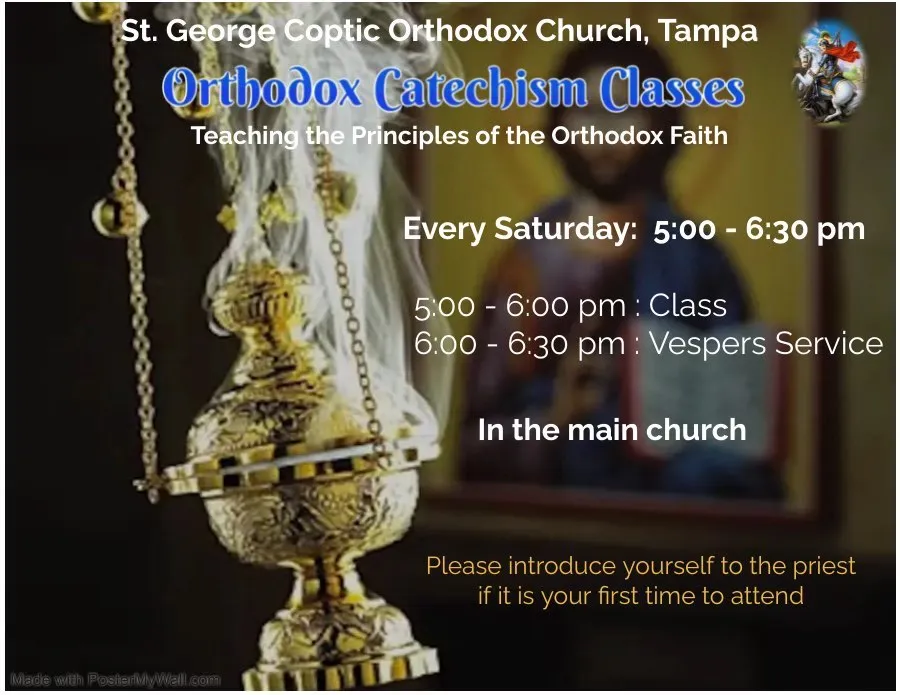
To sign up for the catechism classes, please contact Fr. Joshua: 615-403-7141
Be prepared
What is the Divine Liturgy?
The word liturgy means “the work of the people” and is the original form of the ancient Christian worship. The liturgy includes prayers, hymns (Coptic, Greek, English), readings from the scripture, sermon, worship, and finally receiving the Holy Communion, the true Body and Blood of our Lord Jesus Christ.
Common words used during service:
Key-ryalison: Lord have mercy
Pantocrator: Almighty.
Agios: Holy
Where to stand?
You may notice that men and women stand on opposite sides of the church (Women on the right & men on the left). This is an ancient practice dating back to the early church.
Follow Along
There are overhead screens/monitors to help you follow the prayers.
Incense: Burned to represent prayers rising to God in heaven based on Revelation 8:3-4
The Altar
A table inside the sanctuary where the bread and wine are kept for the entire service
Holy Kiss
Shortly after the sermon, the deacon will call everyone to “Greet one another with a Holy Kiss.” This is meant to fulfill Matthew 5:24. Before receiving the Holy Communion, we extend our hands to one another as a sign of peace.
Holy Communion
Near the end of the service, the priest will distribute the Holy Communion. To participate in communion, you are required to be:
- Baptized into the Coptic Orthodox Faith
- Actively participating in the sacrament of confession
- Abstaining from food and water from midnight
Service Layout
I – Matin: Preparation for the Divine Liturgy – 8:00 am – 8:30 am.
II – The Divine Liturgy: 8:30 am – 11:00 am
Divine Liturgy includes:
A- The Offertory – “Choosing the bread and wine”: 8:30 am – 9:00 am
1- Prayers from the psalms.
2- The priest stands outside the sanctuary to choose the bread and wine while the people are chanting “Key-ryalison” “Lord have mercy.”
3- Thanksgiving prayers.
4- The priest steps outside the sanctuary and prays the absolution while everyone is bowing or sitting down.
B- Liturgy of the Word – “Readings from the Scriptures & the sermon”: 9:00 am – 9:45 am
1- The hymn of intercessions.
2- A reading from the letters of St. Paul.
3- A reading from one of the other letters (James, Peter, John, or Jude).
4- A short hymn.
5- A reading from the Book of Acts.
6- Synxarium: biographies of the martyrs/saints. (On everyday of the Coptic calendar we commemorate the departure of one or more of the saints).
7- The hymn of Agios “Holy.”
8- The priest prays the litany (supplication) of the Gospel as preparation for the Gospel reading.
9- The deacon chants verses from the psalms and reads a passage from the Gospel (Everyone should stand).
10- The Sermon (Everyone sits down).
11- Short hymn “Gospel response.”
Remarks on the Liturgy of the Word
A- During this time, the priest walks in the aisles, incensing the entire church.
B- The people may sit down during the readings but should stand whenever the priest is walking by them with the incense and during the chanting of any hymn.
C- Liturgy of the Faithful – 9:45 am – 11:00 am (everyone stands)
1- The Creed “We believe in One God…”
2- Reconciliation prayer: At the end of this part, the deacon calls everyone to greet one another (Holy kiss).
3- The Anaphora “Lifting up”: The priest starts with “The Lord be with you all.” This part describes the majesty and greatness of God.
4- Agios: This part talks about the story of Salvation.
5- Institutional prayer: selected quotes from the Gospels when the Lord instituted the sacrament of the Eucharist “communion”. At the end of this part, the deacon calls everyone to worship God, the people bow or sit down, the priest calls the Holy Spirit to descend on the bread and wine to transform them into the Body and Blood of Christ.
6- Seven litanies (Peace, Pope/bishops, priests/deacons, mercy, place, air/rivers/plants/fruits/poor/widows/orphans, oblations)
7- Commemoration of the saints: mentioning the names of the heroes of faith.
8- The Fraction: based on the church feasts/fasts. Ends with the Lord’s prayer “Our Father who art in heaven…”
9- Confession of faith “Amen Amen….”
10- People proceed to the side sanctuaries for communion (Deacons, men, women, respectively).
11- Communion is for those who were baptized in one of the following churches:
- Coptic Orthodox Church
- Eritrean Orthodox Church
- Syrian Orthodox Church
- Ethiopian Orthodox Church
- Armenian Orthodox Church
- Indian (Malankara) Orthodox Church

